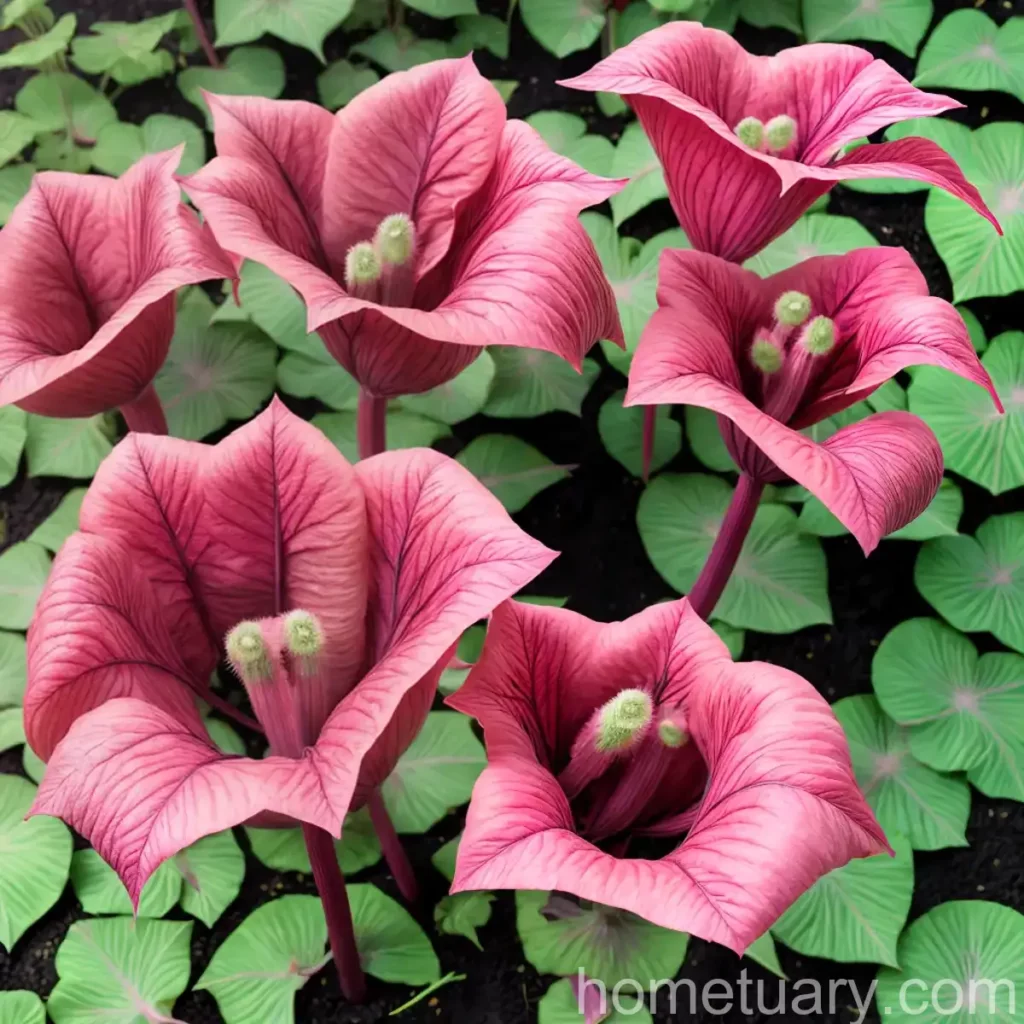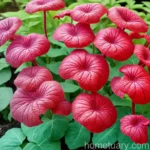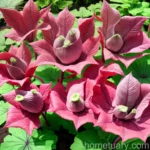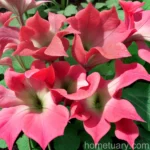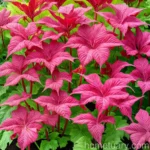Plant Name: “Rhubarb (Rheum x hybridum ‘New Valentine’)”
Rhubarb, scientifically known as Rheum x hybridum ‘New Valentine’, is a perennial plant with long, thick stalks that are commonly used in culinary preparations. It has been cultivated for centuries and is prized for its unique flavor and versatility in recipes. In this comprehensive guide, we will explore the key aspects of growing, cultivating, and maintaining rhubarb (Rheum x hybridum ‘New Valentine’).
What is Rhubarb (Rheum x hybridum ‘New Valentine’)?
Rhubarb is a species of plant that belongs to the family Polygonaceae. Its botanical name is Rheum x hybridum ‘New Valentine’, and it is a hybrid variety known for its robust growth and vibrant red stalks. This perennial plant is known for its tart flavor and is commonly used in pies, jams, and other culinary creations.
Key Takeaways – Rhubarb (Rheum x hybridum ‘New Valentine’)
Before diving into the detailed aspects of growing and caring for rhubarb, let’s highlight some key takeaways about this unique plant:
- Botanical Name: Rheum x hybridum ‘New Valentine’
- Type: Perennial
- Common Uses: Culinary purposes, medicinal applications
- Notable Feature: Tart-flavored, vibrant red stalks
- Cultivation: Best suited for temperate climates
Culture of Rhubarb (Rheum x hybridum ‘New Valentine’)
Cultivating rhubarb (Rheum x hybridum ‘New Valentine’) requires careful attention to its cultural requirements. From water to sunlight and soil conditions, let’s explore the essential cultural factors for growing healthy and productive rhubarb plants.
Water
Rhubarb plants require consistent moisture, especially during their active growth periods. Adequate watering is essential for promoting healthy foliage and robust stalk development. However, it is crucial to avoid overwatering, as this can lead to root rot and other related issues.
Watering Tips for Rhubarb (Rheum x hybridum ‘New Valentine’):
– Ensure that the soil remains consistently moist, especially during dry spells.
– Avoid waterlogging, as excessive moisture can cause rhizome and root damage.
Sunlight
Proper sunlight is crucial for the growth and development of rhubarb plants. While they can tolerate partial shade, they thrive in full sun conditions, which contribute to sturdy stalks and lush foliage.
Sunlight Requirements for Rhubarb (Rheum x hybridum ‘New Valentine’):
– Plant rhubarb in a location that receives at least 6-8 hours of sunlight per day.
– Ensure adequate spacing to prevent shading among the plants.
Fertilizer
Fertilizing rhubarb (Rheum x hybridum ‘New Valentine’) can significantly enhance its growth and productivity. Incorporating organic matter and balanced fertilizers can provide the necessary nutrients for robust stalk production and overall plant vigor.
Fertilization Guidelines for Rhubarb (Rheum x hybridum ‘New Valentine’):
– Apply a balanced fertilizer or compost in early spring to support vigorous growth.
– Avoid excessive application of nitrogen, as this can lead to excessive foliage growth at the expense of stalk production.
Soil
Rhubarb plants thrive in well-draining, fertile soil that is rich in organic matter. The right soil conditions are essential for establishing healthy root systems and promoting robust stalk development.
Optimal Soil Conditions for Rhubarb (Rheum x hybridum ‘New Valentine’):
– Ensure the soil is well-draining to prevent waterlogging and root rot.
– Incorporate organic matter such as compost or well-rotted manure to enrich the soil and support plant growth.
Pruning of Rhubarb (Rheum x hybridum ‘New Valentine’)
Pruning is an essential aspect of maintaining rhubarb plants and promoting their long-term productivity. By removing old stalks and flower stalks, gardeners can ensure that the plant’s energy is directed towards producing robust, edible stalks.
Pruning Guidelines for Rhubarb (Rheum x hybridum ‘New Valentine’):
– Remove flower stalks as soon as they appear to prevent the plant from diverting its energy into seed production.
– Cut back old stalks to the base in late fall or early winter to make way for new growth in the following season.
Propagation of Rhubarb (Rheum x hybridum ‘New Valentine’)
Propagating rhubarb can be achieved through division, allowing gardeners to expand their rhubarb patch and rejuvenate old, overcrowded plants. Dividing rhubarb crowns promotes vigorous growth and ensures the continued productivity of the plant.
Propagation Methods for Rhubarb (Rheum x hybridum ‘New Valentine’):
– Divide mature rhubarb crowns in early spring or late fall, ensuring that each division retains a portion of the root system and at least one bud.
– Plant the divisions in prepared soil and provide ample moisture to support their establishment.
Growing Rhubarb (Rheum x hybridum ‘New Valentine) in Containers
While rhubarb is often grown in traditional garden beds, it is also well-suited for container cultivation, making it an excellent option for gardeners with limited space or those seeking to enjoy fresh rhubarb on patios or balconies.
Key Considerations for Growing Rhubarb (Rheum x hybridum ‘New Valentine) in Containers:
1. Select a large, sturdy container that provides ample room for the rhubarb plant to grow and develop a robust root system.
2. Use well-draining, nutrient-rich potting mix to ensure adequate aeration and support healthy growth.
3. Position the container in a location that receives full sun to partial shade, providing the necessary light conditions for the plant.
4. Water the rhubarb regularly, ensuring that the soil remains consistently moist but not waterlogged.
Popularity of Rhubarb (Rheum x hybridum ‘New Valentine’)
Rhubarb (Rheum x hybridum ‘New Valentine’) has been a beloved plant in gardens and kitchens for generations. Its unique flavor and vibrant appearance have made it a popular choice for culinary applications, where it is prized for its tartness and versatility in various recipes.
The growing popularity of home gardening and the emphasis on using fresh, locally grown produce has further contributed to the resurgence of interest in growing and using rhubarb. As a result, more and more gardeners are seeking to cultivate this versatile plant in their own backyard.
Common Diseases of Rhubarb (Rheum x hybridum ‘New Valentine’)
While rhubarb plants are generally robust and resilient, they can be susceptible to certain diseases that can impede their growth and productivity. Being aware of these common diseases is crucial for implementing preventive measures and maintaining the health of rhubarb plants.
Disease Diagnosis
Some of the common diseases that may affect rhubarb (Rheum x hybridum ‘New Valentine’) include:
- Crown Rot: Caused by various soilborne pathogens, crown rot can lead to the decay of the rhubarb crown and root system, resulting in wilting and overall decline of the plant.
- Leaf Spot Diseases: Fungal diseases such as anthracnose and other leaf spot infections can cause unsightly blemishes on rhubarb leaves, affecting the plant’s overall vigor.
- Powdery Mildew: Characterized by a powdery white growth on the leaves, powdery mildew can weaken the plant and reduce its ability to photosynthesize effectively.
Disease Management and Prevention
Implementing proper cultural practices and maintaining optimal growing conditions can significantly reduce the risk of disease in rhubarb plants. Additionally, regular monitoring and prompt intervention can help mitigate the impact of diseases on the plant.
Disease Management Strategies for Rhubarb (Rheum x hybridum ‘New Valentine’):
– Ensure proper spacing and adequate airflow between plants to reduce the risk of fungal infections.
– Avoid overwatering and waterlogging, as excessive moisture can create favorable conditions for disease development.
– Remove and destroy any infected plant material to prevent the spread of diseases.
Common Pests Affecting Rhubarb (Rheum x hybridum ‘New Valentine’)
In addition to diseases, rhubarb plants may also face challenges from various pests that can impede their growth and compromise their overall health. From insect pests to small mammals, it is essential to be vigilant and proactive in addressing potential pest issues.
Some of the common pests affecting rhubarb plants include:
- Aphids: These small, sap-sucking insects can infest rhubarb plants, leading to distorted growth and potential transmission of viral diseases.
- Slugs and Snails: These voracious herbivores can cause extensive damage to rhubarb leaves and may also feed on young stalks, impacting the plant’s overall productivity.
- Rodents: Small rodents such as voles and mice may feed on rhubarb roots and tubers, causing damage to the underground parts of the plant.
Pest Management Strategies for Rhubarb (Rheum x hybridum ‘New Valentine’):
– Use physical barriers such as row covers or netting to protect young plants from pest damage.
– Encourage natural predators of pest insects, such as ladybugs and lacewings, by providing diverse habitats and nectar-rich flowers in the garden.
– Regularly inspect the plants for signs of pest infestations and take appropriate measures to address the issue.
Botanist’s Tips for Growing Rhubarb (Rheum x hybridum ‘New Valentine’)
Drawing on the expertise of botanists and experienced gardeners, here are some valuable tips for successfully growing and caring for rhubarb (Rheum x hybridum ‘New Valentine):
- Selecting Varieties: When choosing rhubarb varieties, consider attributes such as stalk color, flavor, and overall productivity to suit your culinary preferences and growing conditions.
- Soil Preparation: Prior to planting rhubarb, prepare the soil by incorporating organic matter and ensuring proper drainage, which is essential for establishing healthy plants.
- Harvesting Best Practices: Harvest rhubarb stalks by gently pulling and twisting them from the base of the plant, taking care not to damage emerging stalks or the crown.
- Overwintering: In regions with cold winters, consider mulching around the base of the rhubarb plant in late fall to protect it from freezing temperatures and maintain its vigor.
- Companion Planting: Explore companion planting options to enhance the growth and resilience of rhubarb, considering plants that repel pests or improve soil conditions.
Fun Facts about Rhubarb (Rheum x hybridum ‘New Valentine’)
- The vibrant red stalks of rhubarb are often mistaken for fruit, but in reality, they are the edible petioles of the plant’s leaves.
- Rhubarb is often referred to as the “pie plant” due to its frequent use in sweet and savory pie recipes, where its tart flavor adds a delightful contrast to other ingredients.
- The leaves of the rhubarb plant contain high levels of oxalic acid and should not be consumed, as they can be toxic. However, they can be composted or used as a natural pest deterrent in the garden.
Links to External Resources
For further information on rhubarb (Rheum x hybridum ‘New Valentine’), including cultivation tips, recipes, and health benefits, explore the following resources:
- National Gardening Association – Growing Rhubarb
- University of Minnesota Extension – Rhubarb for Home Gardens
- BBC Good Food – Rhubarb Recipes
- Medical News Today – Health Benefits of Rhubarb
- Rhubarb Central – Comprehensive Rhubarb Resource
In conclusion, growing and caring for rhubarb (Rheum x hybridum ‘New Valentine’) can be a rewarding experience, offering an abundance of delicious stalks for culinary delights and adding aesthetic appeal to the garden. By understanding and implementing the essential cultural practices outlined in this guide, you can cultivate healthy, productive rhubarb plants and enjoy the many delights they have to offer. Whether you’re a seasoned gardener or a beginner, incorporating rhubarb into your garden can be a delightful and fruitful endeavor.
Remember to explore the diverse culinary uses of rhubarb and share the bountiful harvest with friends and family, spreading the joy of this unique and versatile plant. Happy gardening and happy rhubarb harvesting!

